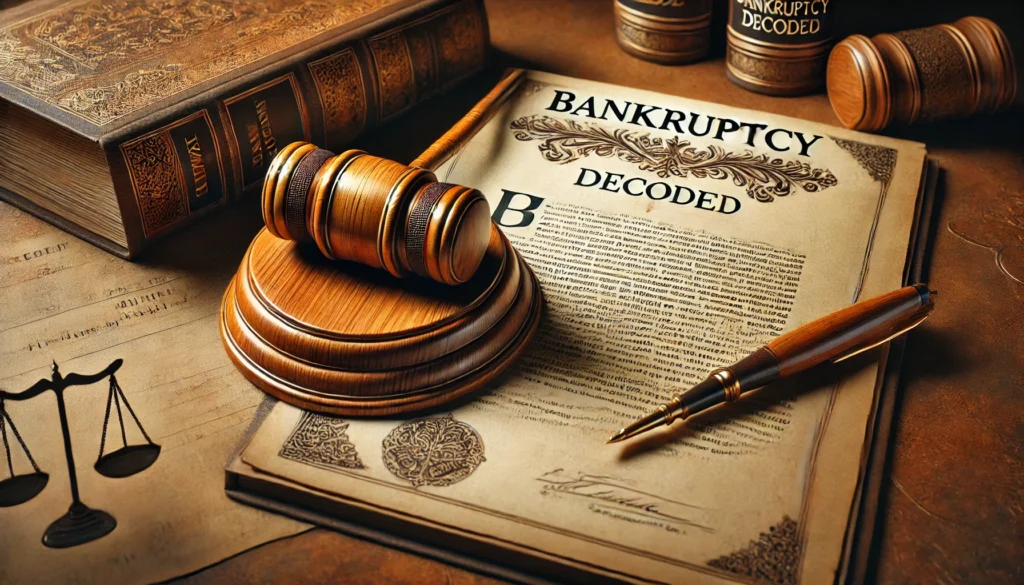Through the legal process of bankruptcy, people and companies who are overburdened by debt can start over financially. This guide explores the intricate details of bankruptcy, offering insights into its types, processes, and long-term implications. Knowing Bankruptcy Decoded can help you confidently handle this challenging procedure.
What is Bankruptcy?
Bankruptcy is a federal court procedure designed to help individuals and organizations eliminate or repay their debts under the guidance of bankruptcy laws. Bankruptcy Decoded sheds light on how this process works as a tool for financial rebirth, enabling debtors to either discharge their obligations or create manageable repayment plans.
Types of Bankruptcy Explained
In the United States, there are several types of bankruptcy, each tailored to different financial situations:
- Chapter 7: Liquidation bankruptcy, which involves selling non-exempt assets to settle debts.
- Chapter 11: Reorganization bankruptcy, typically used by businesses to restructure debt.
- Chapter 13: Wage earner’s bankruptcy, allowing individuals to repay debts over three to five years.
When you approach Bankruptcy Decoded, understanding these types can help determine the best path for your situation.
Who Qualifies for Bankruptcy?
Qualifying for bankruptcy depends on the type you file. For Chapter 7, you must pass a means test proving limited disposable income. Chapter 13 requires proof of regular income to create a repayment plan. Bankruptcy Decoded clarifies the eligibility requirements, making the decision process less daunting.
The Bankruptcy Filing Process
Filing for bankruptcy involves a series of steps:
- Credit Counseling: Mandatory pre-filing counseling from an approved agency.
- Filing a Petition: Submitting paperwork, including financial statements and debt details, to the court.
- Automatic Stay: A legal order that halts creditor actions once bankruptcy is filed.
- Meeting of Creditors: A hearing where creditors can ask questions.
By examining Bankruptcy Decoded, individuals can prepare for these critical steps to ensure a smoother process.
The Role of a Bankruptcy Trustee
A trustee is assigned to oversee the bankruptcy case. Their responsibilities include reviewing financial documents, ensuring compliance with laws, and distributing assets in liquidation cases. Bankruptcy Decoded explains how trustees play a pivotal role in achieving a fair resolution for all parties.
Benefits of Filing for Bankruptcy
While filing for bankruptcy may seem like a last resort, it has significant benefits:
- Debt Relief: Elimination or restructuring of overwhelming debts.
- Protection from Creditors: An automatic stay halts collection efforts.
- Fresh Start: Opportunity to rebuild credit and financial stability.
Bankruptcy Decoded highlights these advantages, showing how the process can be a step toward recovery rather than defeat.
The Downsides of Bankruptcy
Bankruptcy isn’t without its drawbacks:
- Credit Score Impact: A bankruptcy filing remains on your credit report for 7–10 years.
- Loss of Assets: Some non-exempt assets may be sold.
- Limited Access to Credit: Securing loans or credit can become challenging.
Bankruptcy Decoded delves into these issues, emphasizing the importance of careful consideration before filing.
Life After Bankruptcy
Emerging from bankruptcy is not the end—it’s the beginning of financial rebirth. Steps to rebuild your financial health include:
- Budgeting: Create a realistic spending plan.
- Credit Repair: Use secured credit cards to rebuild credit.
- Savings: Build an emergency fund to avoid future crises.
With Bankruptcy Decoded, you can chart a clear path toward financial stability post-bankruptcy.
Alternatives to Bankruptcy
Before filing, explore other options:
- Consolidating several: debts into a single, affordable payment is known as debt consolidation.
- Working: with creditors to lower interest rates or settle debts is known as negotiation.
- Credit Counseling: Professional guidance to manage debt effectively.
Bankruptcy Decoded emphasizes that bankruptcy should be a last resort, and alternative strategies may be viable solutions.
Bankruptcy Laws Around the World
Bankruptcy laws vary by country. While the U.S. emphasizes a debtor-friendly approach, other nations may have stricter regulations. Understanding these laws can be beneficial for expatriates or international businesses. Bankruptcy Decoded explores global perspectives, broadening the understanding of financial recovery.
Conclusion: Embracing Financial Rebirth
Bankruptcy Decoded is not just a guide to navigating bankruptcy—it’s a roadmap to reclaiming financial stability. While the process can be challenging, it provides an opportunity to start anew, free from the burden of insurmountable debt. By understanding the steps, benefits, and challenges, individuals and businesses can approach bankruptcy as a tool for transformation, paving the way for a brighter financial future.
Article Recommendations
Port St. Lucie Mesothelioma Lawyer Vimeo: A Victim\u2019s Guide to Finding Legal Help and Resources

